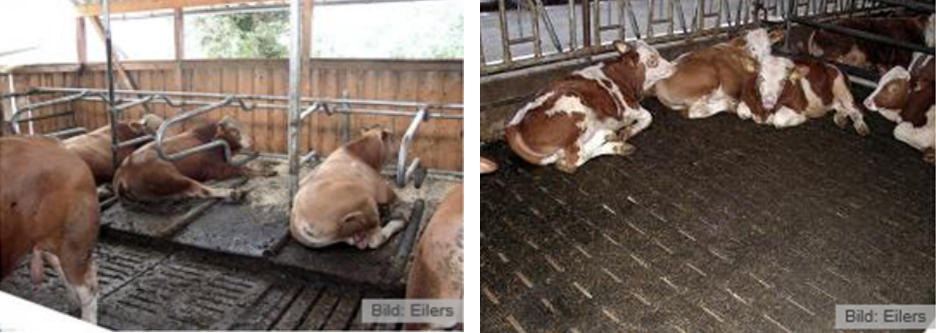Beef cattle are still mostly kept on fully slatted floors. Rubber mats make concrete slats more animal-friendly and are also preferred by animals. Due to the significantly lower abrasion of the claws, it is recommended to limit the keeping period to a maximum of twelve months. Otherwise a correction cut of the claws would be necessary. Limited net growth of the claws by increased animal welfare is possible by a division of the pen in one part with concrete slats and a softer floor in another part. However, since the soft surface must offer sufficient space for all animals to lie down, the space requirement per animal is greater due to the structure of the pen. The feeding area in the front part of the pen with concrete slats then takes up about 45 percent of the pen and the rear part as a lying area takes up 55 percent of the pen. In existing buildings, the pens are often not deep enough to make this subdivision possible. Therefore, a combination of a pre-fattening phase (up to 400 kg) without and a fattening phase with rubberized slats might be a solution.
This variant would have the effect of decreased changes in the joints, which can be observed on concrete floors, especially in the last part of the fattening. However, there are various other variants to combine the advantages of both floors in existing buildings, for example creating deeper pens by moving the outer wall. The space gained in this way can be used for the lying area with rubberized slats. For better cleanliness of the animals and a lower ammonia load in the pens, the lying area can be equipped with a slope of about five percent towards the slot. This favors the drainage of liquids and the surface dries faster. In addition to rubberized slats, fully slatted pens can also be converted by installing cubicles or areas with deeplitter and a slope to drop the litter to the outer wall. The unchanged fully slatted bay represents the feeding place.
 Eilers, U. ; Fink, T. (2019): Tierwohl auch in der Rindermast ein Thema. https://www.badische-bauern-zeitung.de/tierwohl-auch-in-der-rindermast-ein-thema
Eilers, U. ; Fink, T. (2019): Tierwohl auch in der Rindermast ein Thema. https://www.badische-bauern-zeitung.de/tierwohl-auch-in-der-rindermast-ein-thema The advantage of the higher space allowance in pens with combinations of different floors is a decreased fattening time due to higher daily weight gain. Bulls are cleaner in larger pens and do not fight more / injure each other more. Cubicles as lying area are space saving but have to be cleaned regularly, this means extra work and is only possible if the bulls are fixated or not in the pen. Straw means extra work due to sprinkling and removing and is expensive (Eilers, U.; Fink, T. 2019)
Increased space is necessary for a combination of different floors. This does not increase fighting or dirty animals. However, it increases daily weight gain.
This Research Innovation has an Impact on:
- Socio-economic resilience: The combination of two different floors in a pen for fattening bulls is connected to increased costs for the flooring of the lying area. However, it will end in animals that are more healthy and thus receive better prices.
- Animal health and welfare: A combination of concrete flooring in the feeding area and a softer floor in the lying area combines sufficient claw wear with decreased injuries on the carpal joints. Comfort around resting is increased for the animals, too.
- Production efficiency and meat quality: Animals react to an enlarged space with higher daily weight gain and less lameness contribute to a higher weight gain. Thus, a different layout of the pens for fattening bulls can be interesting for product efficiency.
A presentation and discussion on this topic was given in Poland, the report can be seen here.